University of Applied Arts Vienna presents 15 architecture student projects
Dezeen School Shows: a project that redefines the concept of home is included in Dezeen's latest school show by students at the University of Applied Arts Vienna.
Also included is a building with filters that manipulate the occupants' senses and a pavilion that uses a thoughtful arrangement of columns to create choreographed viewpoints of the surrounding landscape.
University of Applied Arts Vienna
Institution: University of Applied Arts Vienna
School: Institute of Architecture
Course: Master of Architecture
Tutors: Prof Cristina Díaz Moreno, Prof Efrén García Grinda, Prof Greg Lynn, Prof Hani Rashid, Hannes Traupmann, Christopher Gruber, Anna Gulinska, Lorenzo Perri, Zsuzsa Péter Gonzalo Vaillo, Martin Murero, Maja Ozvaldic, Lenia Mascha, Bence Pap, Sophie C Grell, Eldine Heep, Jose Carlos Lopez Cervantes and Sophie Luger
School statement:
"The Institute of Architecture at the University of Applied Arts Vienna/die Angewandte offers a three-year accredited master's programme focused on experimental and innovative design in architecture and urban practices.
"The institute is embedded in an internationally renowned applied arts university that fosters interdisciplinary collaboration, provides state-of-the-art education in artistic fields and research, and promotes global exchange.
"With its international orientation and profound artistic, technical and discursive educational programme, the Institute of Architecture produces critical work and searches for visionary strategies that address the most urgent questions of our time and the near future.
"To create new schemes and visions in education, research and practice that address these challenges, architecture at the Institute of Architecture is taught as an integrative discipline by promoting interdisciplinary project processes and working methods from the very local to the planetary.
"Just as there are many areas and niches within architecture and the professional field of architects, the university proclaims diversity on all levels, including teaching.
"Consequently, the autonomy of all the institute's design studios and departments is crucial and considered to be productive, provoking more critical discourse, projects and dynamics."
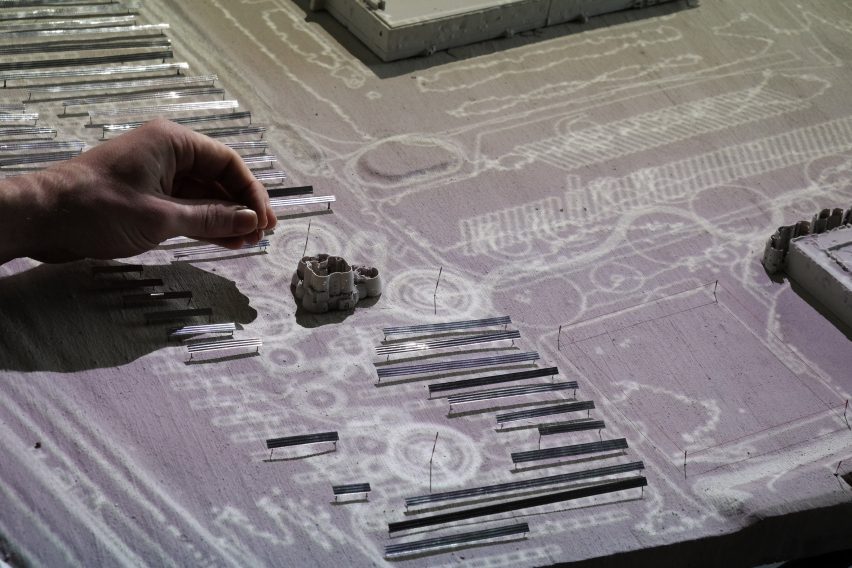
Hardware and Soft Bodies by Alexander Klapsch
"Hardware and Soft Bodies proposes a communal landscape within a city that is close to being consumed by infrastructure.
"Within Mariendorf, a logistics hub in Berlin, the project challenges the role of over-rationalised environments beyond pure functionality, reimagining them as opportunities to restore human conditions.
"As a public landscape emerging from infrastructural processes, the project takes shape through a collection of artefacts placed within the empty spaces of warehouses and data centres.
"The new structures serve as gathering spaces for maintenance workers between day and night shifts. These structures are influenced by the rhythms of machines and patterns of sheep grazing under solar plants."
Student: Alexander Klapsch
Studio: Studio diazmoreno garciagrinda
Tutors: Cristina Díaz Moreno, Efrén García Grinda, Hannes Traupmann, Christopher Gruber, Anna Gulinska, Lorenzo Perri, Zsuzsa Péter and Gonzalo Vaillo
Email: alexander.klapsch[at]gmail.com
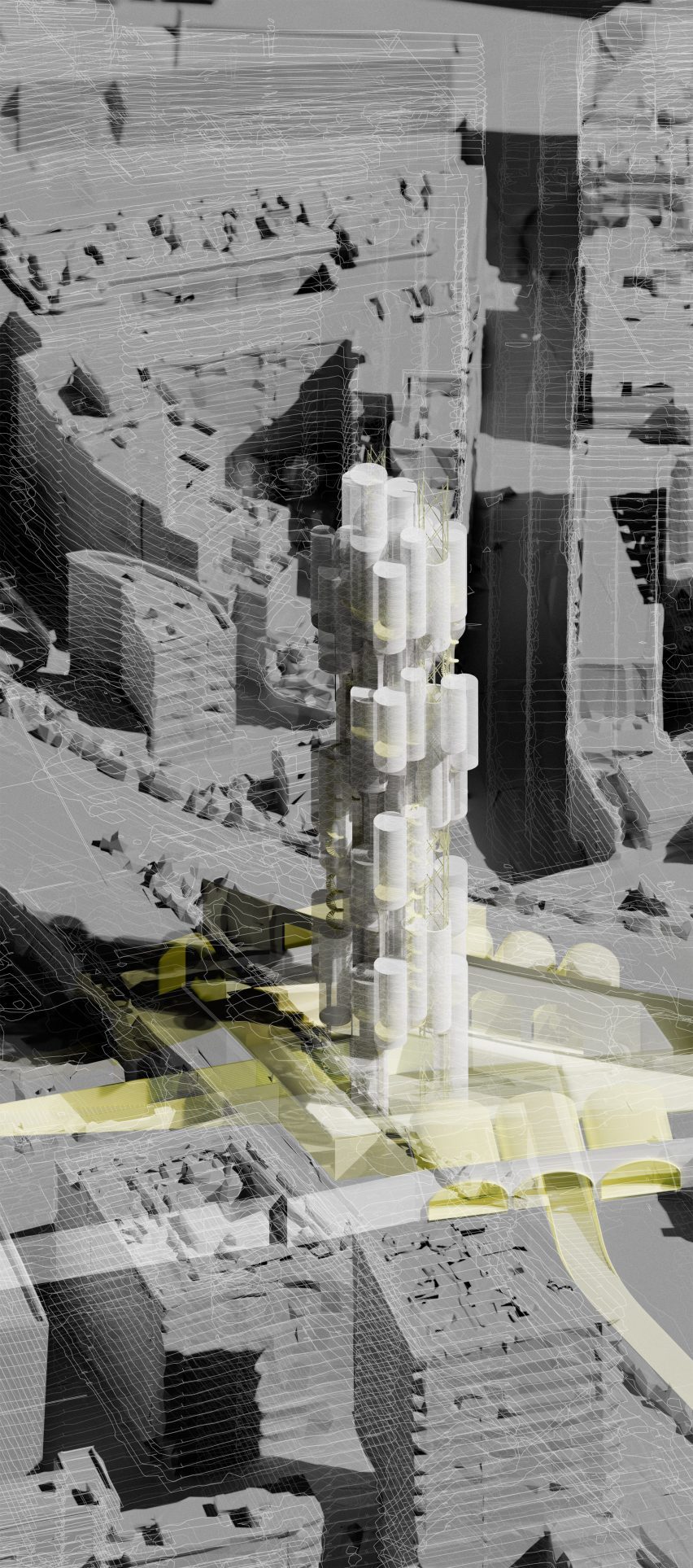
Vertical Grounds of Public Indulgence by Alma Kelderer
"Vertical Grounds of Public Indulgence proposes a hybrid structure at the intersection of a vertical winery and a civic space. It is dedicated to tasting and leisure to complement London's newly emerging urban vineyards.
"This project proposes an approach to utilising vertical space as a new civic hub, using different forms of manufacturing and cultural involvement.
"It investigates how spatial intersections, tectonic clusters and geometric intricacy could support this space architecturally.
"The project questions whether the environment where wine is made is solely a space for manufacturing, envisioning future possibilities of our common food territories."
Student: Alma Kelderer
Studio: Studio diazmoreno garciagrinda
Tutors: Cristina Díaz Moreno, Efrén García Grinda, Hannes Traupmann, Christopher Gruber, Anna Gulinska, Lorenzo Perri, Zsuzsa Péter and Gonzalo Vaillo
Email: alma.kelderer[at]hotmail.de

Geologies of Accumulation by Diana Cuc
"This project explores the inhabitation of spaces that mediate between the artificial and natural processes involved in constructing traditional urban structures.
"It investigates the interaction between man-made systems and local resources, as well as the relationship between architectural space and geological history.
"Set in Paris, France, it serves as an investigation into what it means to inhabit an environment with ongoing construction.
"The project mediates controlled and uncontrolled material movements, bridging predefined spatial occupancy with subjective interpretations.
"It poses questions on what we can learn from viewing buildings not as final products, but as a collection of spatial opportunities created from construction processes."
Student: Diana Cuc
Studio: Studio diazmoreno garciagrinda
Tutors: Cristina Díaz Moreno, Efrén García Grinda, Hannes Traupmann, Christopher Gruber, Anna Gulinska, Lorenzo Perri, Zsuzsa Péter and Gonzalo Vaillo
Email: cuc.diaana[at]yahoo.ro
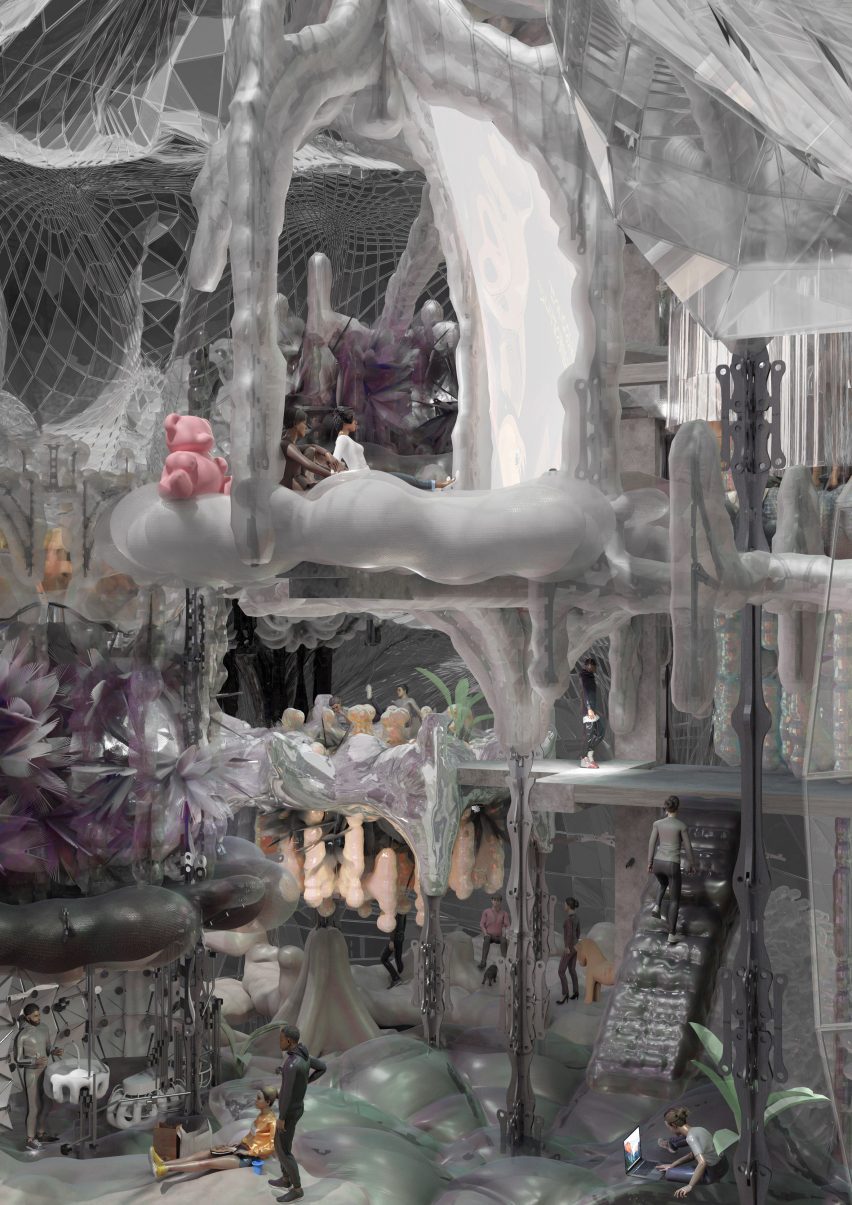
No Place Like Home – From Late Till Early and Everything In Between by Jenny Niklasch
"This project addresses themes of identity, comfort and belonging, envisioning a new realm that reflects a social world.
"This living environment is constructed by reconfiguring and reassembling elementary parts commonly found in our domestic surroundings and appliances.
"As a result, the concept of a home is no longer viewed as an unchanging space for our belongings but as a place that is activated through the interaction of individuals.
"This interaction creates an interface that merges leisure and necessity, allowing for the emergence of a new contemporary complex within an abandoned building near Alexanderplatz, Berlin."
Student: Jenny Niklasch
Studio: Studio diazmoreno garciagrinda
Tutors: Cristina Díaz Moreno, Efrén García Grinda, Hannes Traupmann, Christopher Gruber, Anna Gulinska, Lorenzo Perri, Zsuzsa Péter and Gonzalo Vaillo
Email: jenny_niklasch[at]outlook.de
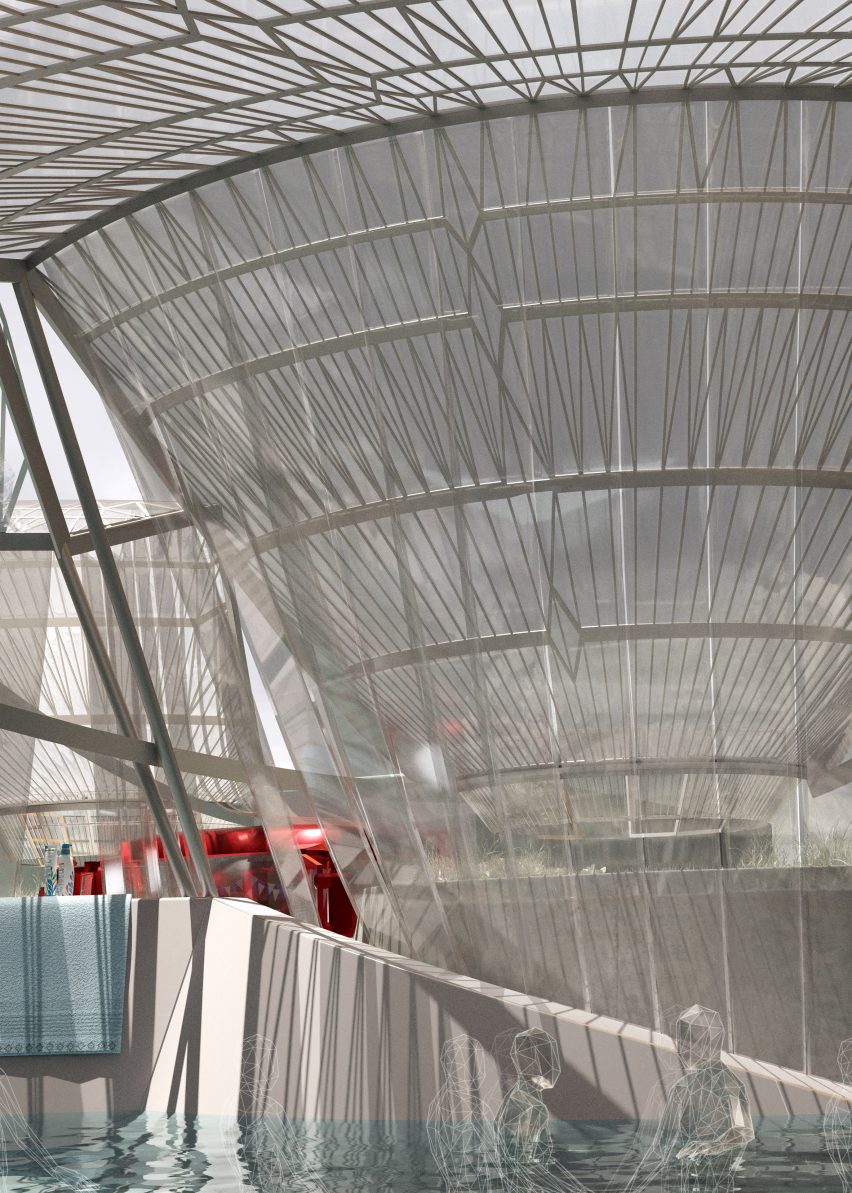
Within Milieus of Movement by Moritz Kühn
"This project engages with different scales of European logistics and explores how economic forces physically manifest in the built environment and its impact.
"Following a study of a logistics park in the Czech Republic, the project proposes an urban system to reconnect infrastructural connection points to their surroundings.
"This project introduces different approaches to temporary habitation and dwelling within infrastructure spaces by integrating hybrid programmes into vacant areas between warehouses.
"This is achieved through the use of roof modules, earthworks and pathways designed for humans and machines.
"These infrastructural node points possess a physical presence and impact on the site. Therefore, the project is an investigation into effectively managing infrastructure spaces, its users and the remoteness it produces."
Student: Moritz Kühn
Studio: Studio diazmoreno garciagrinda
Tutors: Cristina Díaz Moreno, Efrén García Grinda, Hannes Traupmann, Christopher Gruber, Anna Gulinska, Lorenzo Perri, Zsuzsa Péter and Gonzalo Vaillo
Email: kuehnmoritz[at]gmx.de
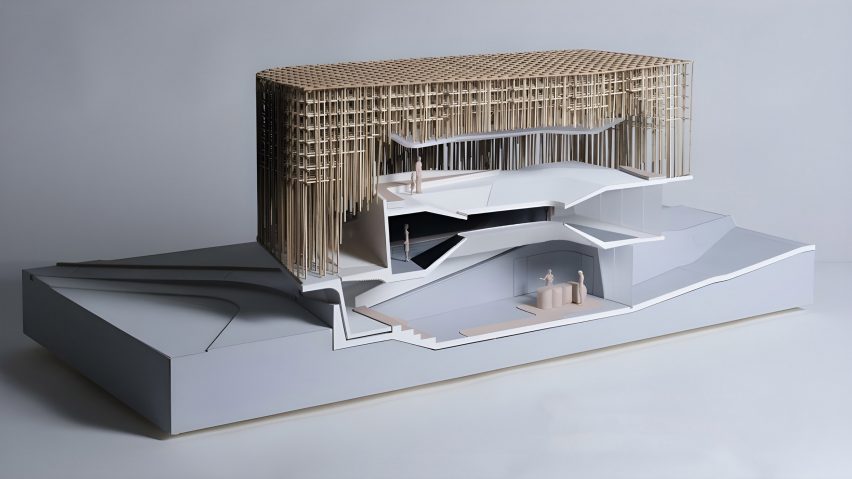
Filtered Transmission by Tobias Haas
"Users can interact with the RB19 racing car with a series of architectural filters that gradually unveil more information about the vehicle.
"These filters are designed to manipulate the perception of light, material, texture and social interactions of visitors.
"By gradually revealing information and detaching visitors from the outside, the sensory experience within the space is intensified, ultimately creating an immersive experience."
Student: Tobias Haas
Studio: Studio Greg Lynn
Tutors: Greg Lynn, Martin Murero, Maja Ozvaldic, Lenia Mascha and Bence Pap
Email: haastobias[at]yahoo.de
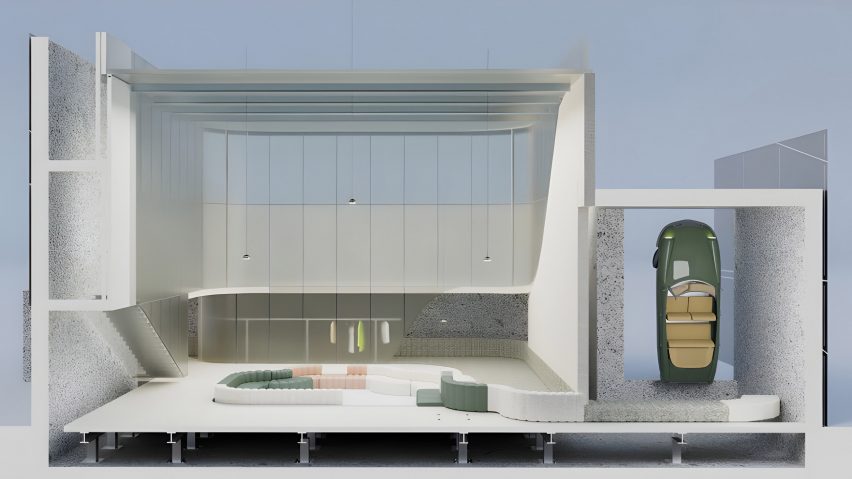
Surface Language by Anna Chakhal Salakhova
"This project aims to transform an object into a physically immersive space using materials with different qualities.
"Rather than starting with form, the design process began with the selection of materials. This then influenced the shape and form of the space as the design developed.
"The space serves as a reflection of the object's history, providing unique and intimate engagement.
"The space aims to create a memorable and impactful encounter that deepens the visitors' connection with the brand and the car."
Student: Anna Chakhal Salakhova
Studio: Studio Greg Lynn
Tutors: Greg Lynn, Martin Murero, Maja Ozvaldic, Lenia Mascha and Bence Pap
Email: chakhalsalakhova[at]gmail.com
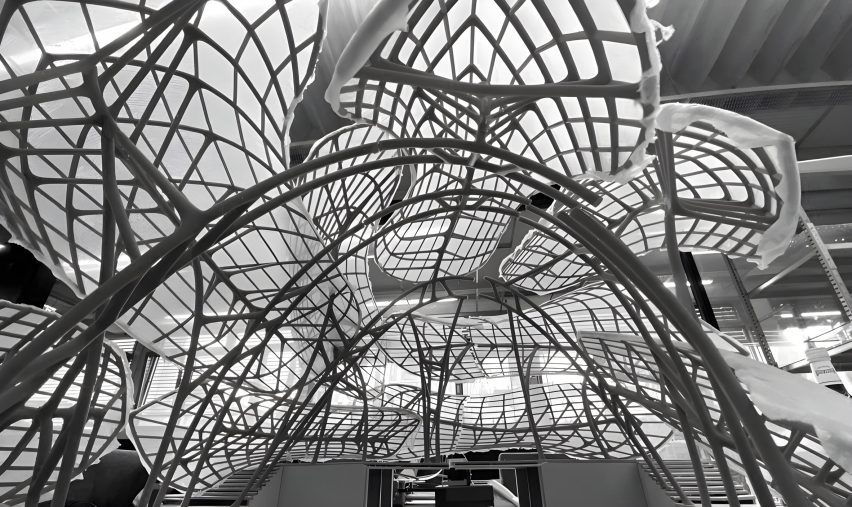
Surface Language by Weichen Zhou, Markus Lagler and Danylo Durbak
"The 'house within a house' concept is inspired by the Sydney Opera House, designed by Jørn Utzon. The richness of spatial layering and intermediary spaces informed the initial idea for this project.
"The history that contrasts the futuristic concept behind the Citroen DS19 car model with its articulate surface language determines the exhibition design, atmosphere and key design decisions, positioning the car in space.
"The visitors are constantly immersed in visual interactions with the car as they are guided through a sequence of intermediary spaces."
Students: Weichen Zhou, Markus Lagler and Danylo Durbak
Studio: Studio Greg Lynn
Tutors: Greg Lynn, Martin Murero, Maja Ozvaldic, Lenia Mascha and Bence Pap
Emails: jowcharly[at]gmail.com, markus.lagler[at]gmx.at and ddurbak3498[at]gmail.com
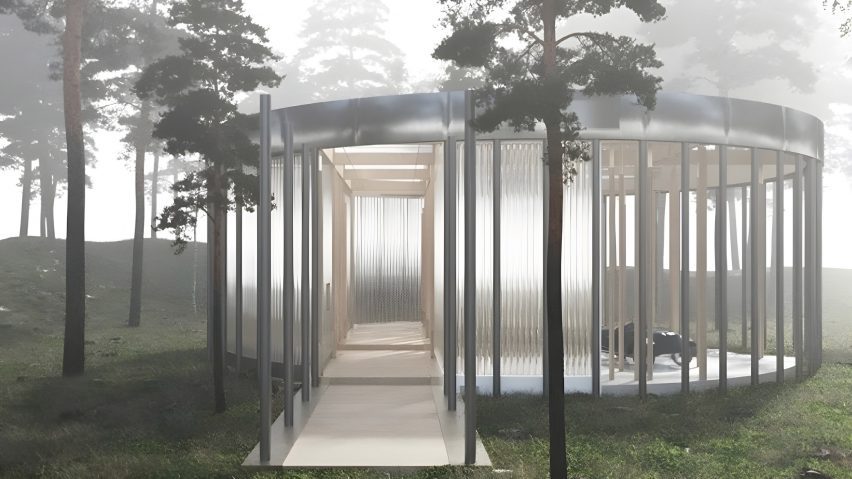
Surface Language by Natalia Laskovaya and Anastasiia Shevchenko
"The pavilion serves as a monument, highlighting the temporality of human-made items.
"The materiality and tectonics of the design create a clear contrast and opposition between the eternal world of nature and the impermanent world of temporary objects.
"Columns of different diameters and materials are the main element in the pavilion, designed to open up the space.
"Columns serve as guides for tours and frame the views, creating choreographed viewpoints. The colonnade extends into a continuation of a forest with reflective walls pointing the way.
"Within this space, the perception of an object is distant and mysterious, and nature serves as the backdrop."
Students: Natalia Laskovaya and Anastasiia Shevchenko
Studio: Studio Greg Lynn
Tutors: Greg Lynn, Martin Murero, Maja Ozvaldic, Lenia Mascha and Bence Pap
Emails: laskovayanatasha[at]gmail.com and asya.shevchenko13[at]gmail.com
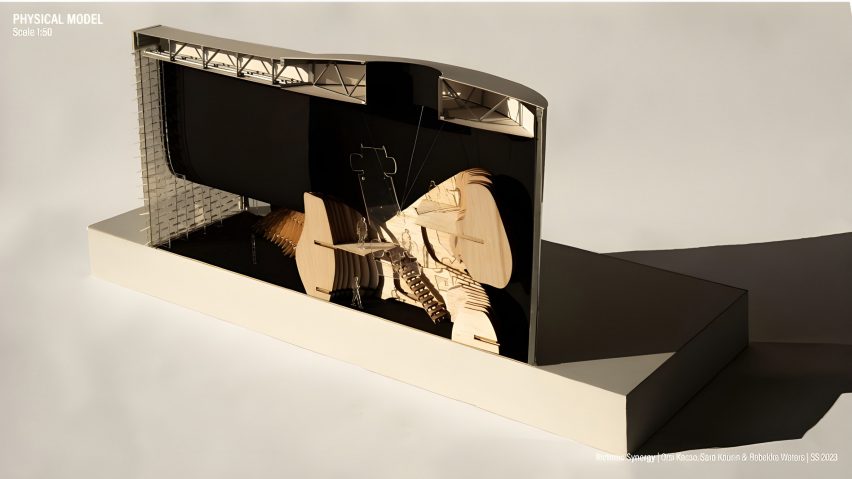
Tectonic Synergy by Orsolya Kacso, Rebekka Waters and Sara Kaurin
"The proposed concept for this single-room building aims to create an illusion through a tectonic synergy. This synergy emphasises the relationship between the structure, the envelope and the visitor.
"The timber structure is designed to envelop the showcased object, a Formula One racing car.
"This is encased within a steel frame, combined with precast concrete elements.
"The external envelope has a matte white plaster finish, juxtaposed with a black plaster interior that adds depth to the room and surprises the visitor upon their initial entry.
"The laminated timber frame provides structure and curates the openings of the object, guided by the motion of the visitor inside."
Students: Orsolya Kacso, Rebekka Waters and Sara Kaurin
Studio: Studio Greg Lynn
Tutors: Greg Lynn, Martin Murero, Maja Ozvaldic, Lenia Mascha and Bence Pap
Emails: orsolyakacso[at]outlook.com, rwaters[at]laurentian.ca and sarakaurin[at]hotmail.com
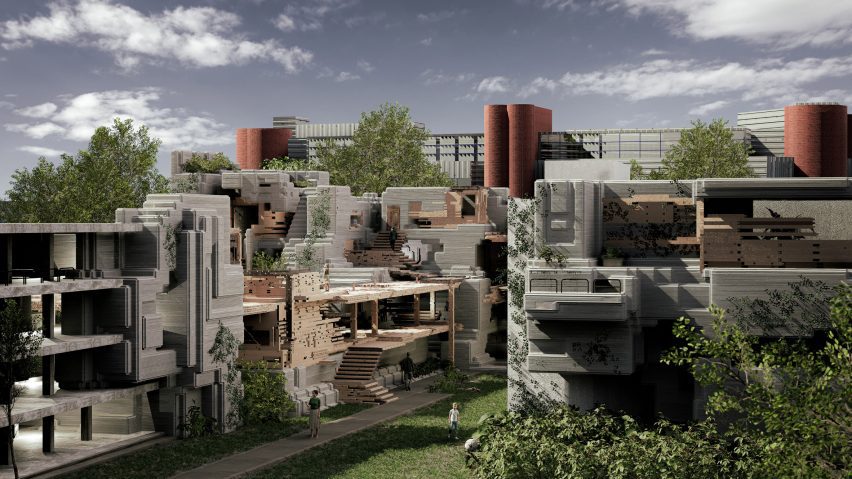
Contextual_Convergence by Tilman Fabini, Oliver Hamerdinger and David Kipp
"The site for this project spans from Heiligenstadt to Spittelau in Austria. The site is dominated by private modes of transport and expansive storage spaces – they are space-consuming and result in disconnected islands.
"The project aims to establish a horizontal connection, reinvigorating the area by reclaiming infrastructural spaces. Nested into the context, it does not neglect the existing but suggests conscious additions to the cityscape.
"The design methodology of this project features the use of computational and data-driven technologies to explore behavioural analysis.
"By employing layered models of artificial intelligence (AI) that incorporate extensive contextual data and manual design inputs, this project is able to identify future zones of development and intervention on an urban scale.
"In doing so, the project aims to predict a new way of co-existing within an architectural domain. It explores how the procedural design process can emerge from the fusion of human and machine intelligence, resulting in design methodologies that lead to unfamiliar and ambiguous outcomes."
Students: Tilman Fabini, Oliver Hamerdinger and David Kipp
Studio: Studio Hani Rashid
Tutors: Hani Rashid, Sophie C Grell, Eldine Heep, Jose Carlos Lopez Cervantes and Sophie Luger
Emails: tilman.fabini[at]uni-ak.ac.at, oliver.hamedinger[at]icloud.com and David.kipp[at]uni-ak.ac.at
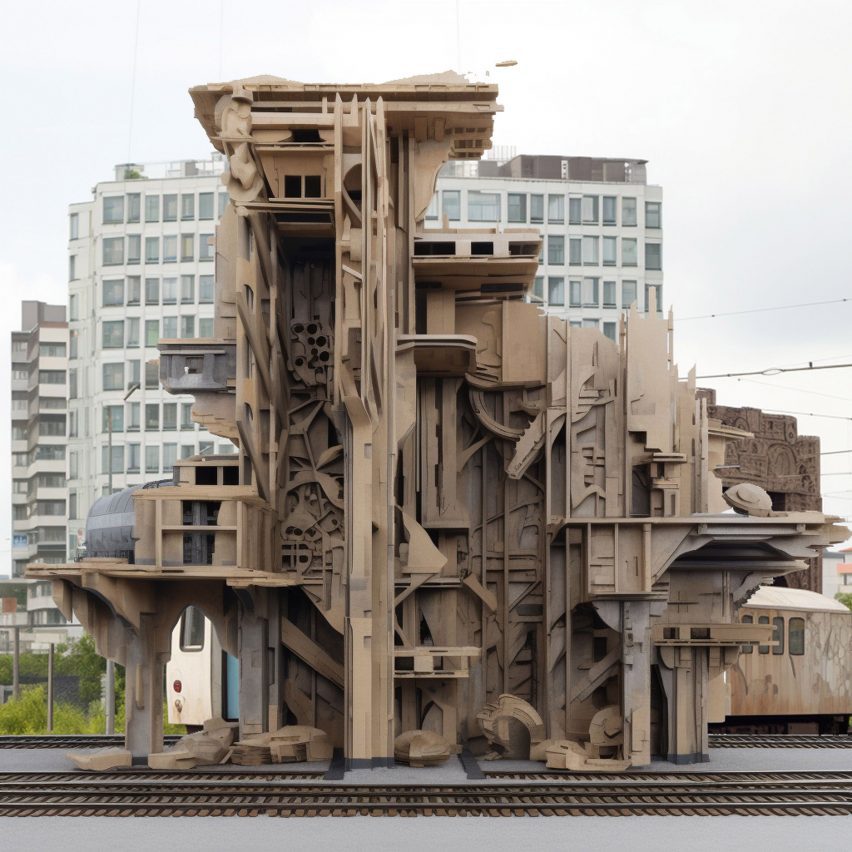
Ouroboros: Residual Morphogenesis by Angelica Cher and Kyryll Dmytrenko
"This project explores and challenges the recent rise of image-generating AI technology, transforming decaying buildings on the site into entirely new aggregations and programmes.
"The project tackles the overall complexity and unpredictability of initial material deposits as a source for new emerging structures using the same complex and unpredictable behaviour of Al-based text-to-image algorithms.
"While each object is different, subtle traces of the building it comprises remain, referencing the surrounding environment while simultaneously rejecting it.
"Ultimately, this allows pedestrians to interact with the same disjointed 'materiality' of the familiar context they are used to."
Students: Angelica Cher and Kyryll Dmytrenko
Studio: Studio Hani Rashid
Tutors: Hani Rashid, Sophie C Grell, Eldine Heep, Jose Carlos Lopez Cervantes and Sophie Luger
Emails: sealunreal[at]gmail.com and kyrydmyry[at]gmail.com
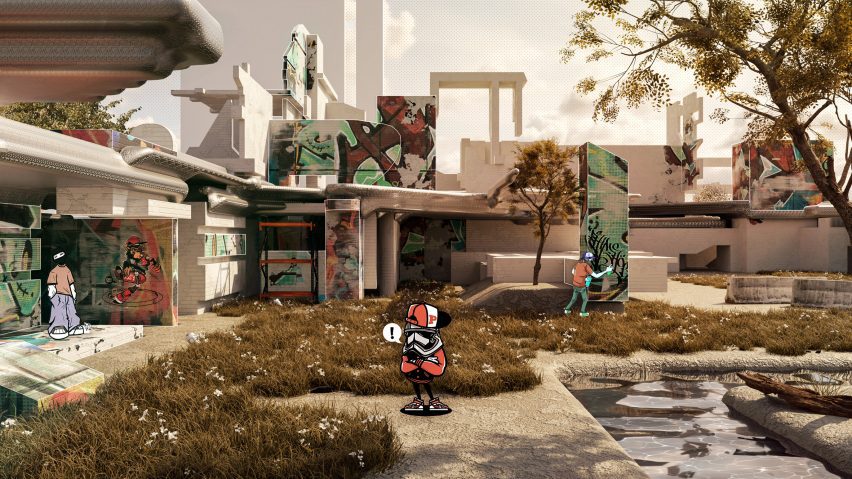
The Urban Canvas: Redefining Vienna's Urban Landscape Through Graffiti and AI by Mohammad Sajad Ghaderi and Soroush Naderi
"This project aims to convert and revitalise a very non-human and commercial part of Vienna, Austria, with an urban body that celebrates intervening spaces for the public.
"With the use of AI as a generative tool rather than a representational one, this project aims to embrace the errors that occur in human and AI interactions and invite unexpected moments by exploring all uncertainties.
"With a non-linear process using trial and error with Midjourney's AI image generation tool, this intervention challenges the design process and opens up new opportunities for imagination.
"In the same way that graffiti dominates urban surfaces and generative AI tools produce images, The Urban Canvas is a manifestation of objects, connections, interpretations and misreadings.
"It enables the public to explore the innermost spatial qualities and occupy the project in imaginative ways that go beyond predefined programming."
Students: Mohammad Sajad Ghaderi and Soroush Naderi
Studio: Studio Hani Rashid
Tutors: Hani Rashid, Sophie C Grell, Eldine Heep, Jose Carlos Lopez Cervantes and Sophie Luger
Emails: ghaderi.sajad[at]gmail.com and soroushndr[at]gmail.com
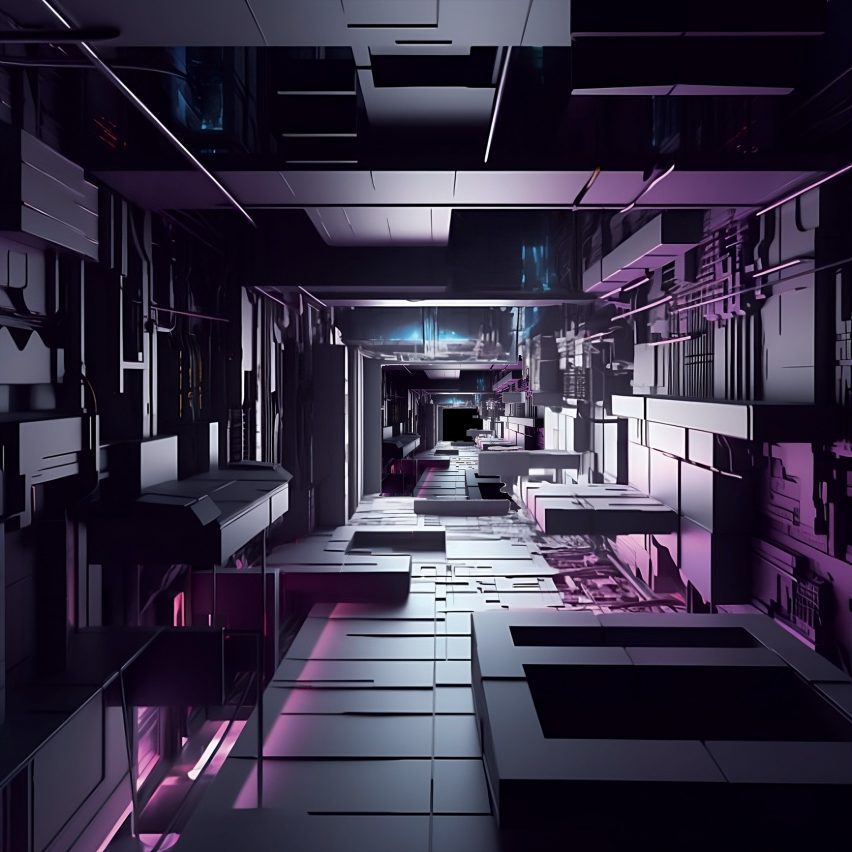
Transcendence: A Cutting-Edge Music AI Installation in Vienna's Industrial Zone by Mohamed Abdelhady and Olja Radovanovic
"Transcendence is an avant-garde architectural marvel integrated within the vibrant industrial landscape of Vienna, Austria. It harnesses the transformative power of AI, revolutionising the field of music.
"Designed as a multifunctional space, Transcendence serves as a musician's sanctuary, artistic residence and a hub for the most extraordinary techno parties in the world.
"Through advanced machine-learning algorithms and incorporation of dynamic architectural elements like shifting walls, sliding panels and morphing surfaces, this project pushes the boundaries of artistic expression.
"It intensifies emotional impact and blurs the boundary between space and sound, captivating visitors within a transformative experience.
"As a haven for techno enthusiasts and a breeding ground for artistic expression, it showcases the limitless possibilities when technology and creativity are combined."
Students: Mohamed Abdelhady and Olja Radovanovic
Studio: Studio Hani Rashid
Tutors: Hani Rashid, Sophie C Grell, Eldine Heep, Jose Carlos Lopez Cervantes and Sophie Luger
Emails: mohamed.yehia.abdelhady[at]gmail.com and olja.radovanovic26[at]gmail.com
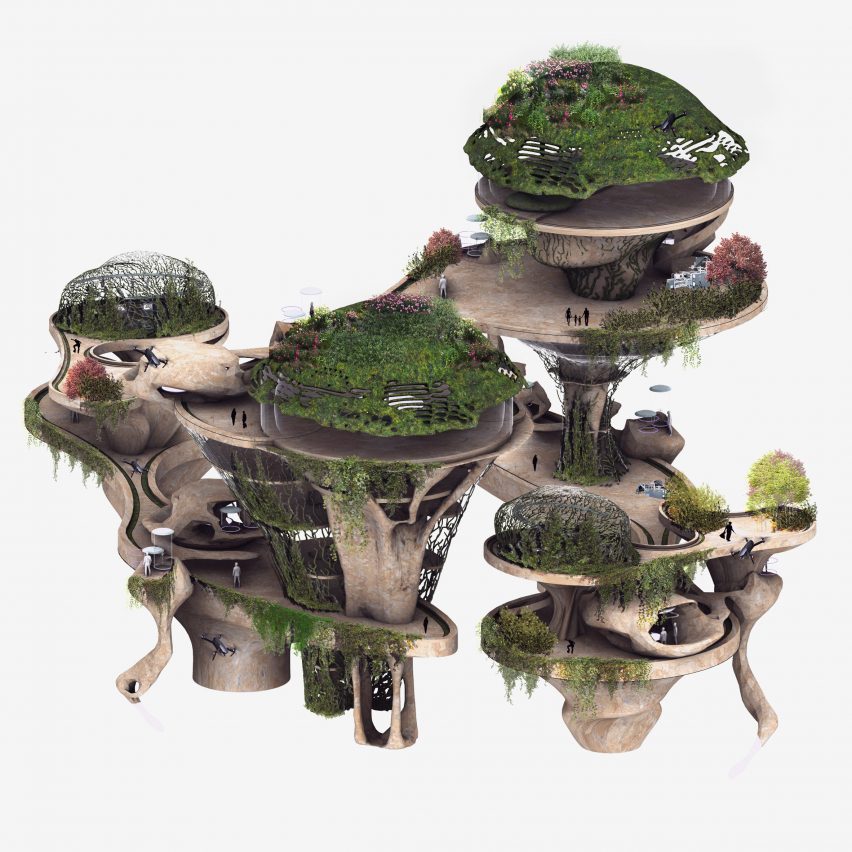
VinAi: AI-Infused Architecture of the City by Maria Gross and Sharon Sarfati
"The rising global temperatures are endangering current wine regions around the world, necessitating solutions to safeguard wine production and the culture developed around it.
"VinAi is an innovative community nestled in the heart of Vienna's metropolitan area. Designed as a modular system of residential units to be integrated within the wine production facilities, the neighbourhood can foster a unique experience between the residents and the vineyards.
"VinAi serves as a testament to the synergy between human ingenuity and AI-driven design tools. Each unit features a combination of residential and lab facilities.
"These modules are connected by green corridors, allowing easy access to the production areas, labs and community facilities."
Students: Maria Gross and Sharon Sarfati
Studio: Studio Hani Rashid
Tutors: Hani Rashid, Sophie C Grell, Eldine Heep, Jose Carlos Lopez Cervantes and Sophie Luger
Emails: mariagross.archi[at]gmail.com and sharon.s2694[at]gmail.com
Partnership content
This school show is a partnership between Dezeen and the University of Applied Arts Vienna. Find out more about Dezeen partnership content here.